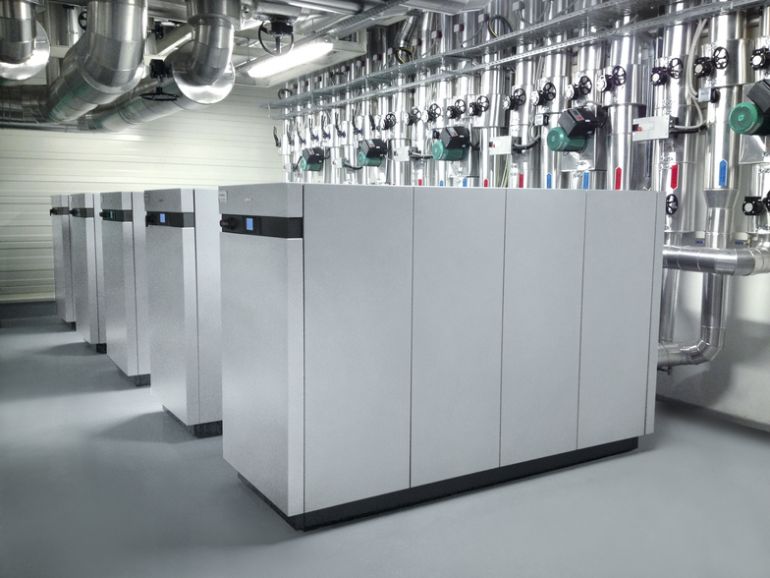Experts of the heating branch harmoniously claim: ground is one of the most stable sources of heat, additionally it is not depended on external conditions. Regardless of the fact if we have a hot summer or maybe we struggle with snow-clearing, in the ground, on the depth of 1,5-5 metres, there is a constant temperature, from 8 to 12° C. Furthermore, this lower source of heat is characterized by very good exploitative parameters.
From the ground
How does a ground heat pump work? Heat, which is accumulated in the ground, is acquired and supplied to rooms of the office through a heating system. Energy is transferred in an evaporator to a working substance, which circulates in a heat pump. The working substance succumbed to the evaporation, thanks to which it receives a certain amount of air from the natural environment. The next stage is a compression of the working substance in a compressor, where its pressure and temperature increase. Then, a steam of a substance is condensed in a condenser, whereupon it transfers its heat to a heating water which supplies the c.o. system (either in water or air – depending on applied installation of a heat’s distribution in the building).
Proper functioning of the system is depended on i.a. appropriate choice of a device’s heating power. A heating power of heat pumps: from 1,7 to 2000 kW, enables to select a proper device to almost every building – emphasizes Krzysztof Gnyra, expert of the Viessmann company. The pump may be the only source of heat or cooperate with others, for instance with a gas, oil-burning boilers, or on wood. It is easy to apply such heatings to both new and modernized building, and different possibilities of a financial support allow to decrease investment costs.
Probes or collectors
Heat from the ground will be acquired with the use of horizontal collectors or vertical ground probes. The selection of a system is primarily depended on sizes and forms of a plot, on which we are planning the building of an office. In case of rather limited sizes and, for instance, a car park located in underground tiers of the building, instead of next to it, a vertical probe will be better, it takes a relatively smaller space. On the other hand, we deal with great power and great demand for heat in office structures so horizontal ground collectors are scarcity due to a required large space ca. 30-50 sq. m on each kilowatt of a pump’s heating power. Thereupon, ground probes are frequently used. They are placed in bores with a depth of nearly 200 m, having a better heat yield and requiring a smaller space. If a decision about heating with the use of a ground heat pump with ground probes is made sufficiently in advance, that is on the stage of a project, then it will be possible to realize bores under a foundation plate, that is “covering” them under the building. The alternative for probes are so called energetic stakes – reinforced concrete stakes are used to stabilize the ground, serving in this case as heat receivers from the ground.
Modern devices
As a result of a great potential, which lies in the market of ground heat pumps, producers devoted a lot of attention to improve certain elements of the device. In the latest models, i.a. advanced technological spiral compressors, enabling to reach high temperatures of condensation at low temperatures of evaporation, were applied. Increasingly high COP of heat pumps is obtained by use of more effective compressors and thanks to optimization of a cooling system, such as e.g.: asymmetric heat interchangers, injection of a hot gas – says Krzysztof Gnyra. Also an automatics gives a lot of possibilities: enables to combine a heat pump with a photovoltaic installation, for the maximum use of a free solar electricity for its own purposes; it optimizes a work of circulation pumps for the maximal efficiency of a heat pump; enables intelligent piloting of heat pumps’ cascade – it continuously controls the COP of each heat pump working in a cascade and on this basis it optimizes its work – continues.
Inverter technique is being also developed. It allows to adjust work parameters of a pump to actual need for heat and lower use of energy related to reduction of a start-time and attainment of a desirable temperature in the shortest possible time.
Important subject: cooling
However, we should remember that an office building is demanding, not only in respect of heating, but also – an effective cooling of interior. Cooling with the use of heat pump occurs in a passive and natural way (based on temperature difference between lower and upper source of energy – the process runs more effectively if this temperature difference is higher, especially on the beginning of a summer season) or active, mechanical. On the other hand, the office’s need for coolness may be so high that it would be necessary to apply more advanced method. In this kind of realizations, first and foremost ice containers will success – a solution implemented primarily in Western Europe (currently in Poland the first installation of this type is being originated). The lower source of heat, instead of a ground probe or collectors, is ice water accumulator. The structure is based on a buried concrete “bell” in the ground, partially filled in water. Never freezing factor flows in a submerged coil in it, which is responsible for transport of an energy acquired by aerial solar absorber (a kind of solar collector), installed at the building.
Although the investment in a ground heat pump does not belong to the cheapest ones (especially if we include the cost of a bores’ realization), basically it means a free energy and stable source of heat and cool. In case of large-cubic structures like offices, a turnaround time will not be high.

